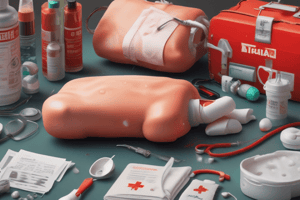Podcast
Questions and Answers
Which of the following is NOT a necessary first aid procedure for treating cuts?
Which of the following is NOT a necessary first aid procedure for treating cuts?
- Calling for emergency assistance (correct)
- Applying a bandage
- Cleaning the wound
- Applying antibiotic ointment
How can knowing common first aid skills help prevent infection and facilitate the healing process?
How can knowing common first aid skills help prevent infection and facilitate the healing process?
Skills such as applying bandages and antibiotic ointment help prevent infections and aid healing.
Compare and contrast the three different classifications of burns.
Compare and contrast the three different classifications of burns.
First-degree burns redden the skin and cause minor pain. Second-degree burns have blisters and increased pain. Third-degree burns result in significant skin loss and nerve damage, which may reduce pain.
Why is the first step in responding to life-threatening situations to assess the situation?
Why is the first step in responding to life-threatening situations to assess the situation?
Burns are classified into four different groups.
Burns are classified into four different groups.
First aid is important because it __________.
First aid is important because it __________.
How can providing first aid care be hazardous for the person providing the assistance?
How can providing first aid care be hazardous for the person providing the assistance?
Which of the following would you NOT expect to find in a standard first aid kit?
Which of the following would you NOT expect to find in a standard first aid kit?
Which of the following procedures for providing first aid for severe bleeding is NOT correct?
Which of the following procedures for providing first aid for severe bleeding is NOT correct?
Cardiopulmonary resuscitation is a first aid technique for individuals in cardiac arrest that involves __________.
Cardiopulmonary resuscitation is a first aid technique for individuals in cardiac arrest that involves __________.
The Heimlich maneuver, or abdominal thrust, should be used when someone is choking.
The Heimlich maneuver, or abdominal thrust, should be used when someone is choking.
The universal sign for choking is __________.
The universal sign for choking is __________.
The acronym CPR stands for __________.
The acronym CPR stands for __________.
First aid for severe injuries should always be followed by professional attention.
First aid for severe injuries should always be followed by professional attention.
People with first aid training can provide less assistance to accident victims than people without first aid training.
People with first aid training can provide less assistance to accident victims than people without first aid training.
Consent from the victim is not always needed before providing first aid.
Consent from the victim is not always needed before providing first aid.
Which type of burn is BEST described as maximum loss of skin, reduced feeling, and almost whitish?
Which type of burn is BEST described as maximum loss of skin, reduced feeling, and almost whitish?
Which type of burn is BEST described as reddish skin, white border, and some pain?
Which type of burn is BEST described as reddish skin, white border, and some pain?
What does the C in the ABCs of resuscitation stand for?
What does the C in the ABCs of resuscitation stand for?
Which of the following is NOT a type of injury commonly treated by first aid?
Which of the following is NOT a type of injury commonly treated by first aid?
If additional bandages are needed for a severely bleeding wound, they should be placed on top of the older bandages.
If additional bandages are needed for a severely bleeding wound, they should be placed on top of the older bandages.
Flashcards are hidden until you start studying
Study Notes
First Aid Overview
- First aid procedures for cuts typically do not require calling for emergency assistance unless the injury is severe.
- Proper first aid skills help prevent infection and promote healing through effective wound cleaning and dressing.
Burn Classifications
- First-degree burns: Minor burns like mild sunburns; cause reddening of the skin and minor pain.
- Second-degree burns: More serious, characterized by blisters and significant pain.
- Third-degree burns: The most severe; result in extensive skin damage and nerve destruction, potentially causing less sensation despite the harm.
Assessing Situations
- The initial step in life-threatening situations is to assess for hazards to ensure the safety of both the first aid provider and the victim before administering aid.
Importance of First Aid
- First aid significantly improves survival rates, reduces permanent injuries, and minimizes infection risks.
Hazards of Providing First Aid
- First aid providers may be at risk if victims have communicable diseases or if environmental dangers (like traffic or unstable structures) persist.
First Aid Kit Contents
- A standard first aid kit typically does not contain neck splints.
Procedures for Severe Bleeding
- Incorrect procedures for severe bleeding include allowing the victim to sit upright; the proper position is usually lying down.
Cardiopulmonary Resuscitation (CPR)
- CPR involves a combination of rescue breathing and chest compressions to aid individuals in cardiac arrest.
Handling Choking Emergencies
- The Heimlich maneuver (abdominal thrust) is critical for choking victims.
- The universal sign for choking is two hands grasping the throat.
Acronyms and Key Terms
- CPR stands for Cardiopulmonary Resuscitation, critical for resuscitation efforts.
- The letter "C" in the ABCs of resuscitation refers to "Circulation," a core focus during heart emergencies.
Treatment and Consent
- Professional medical attention must follow first aid for severe injuries.
- Consent is not always necessary for administering first aid, particularly if the victim is unresponsive.
Understanding Burns
- Third-degree burns: Characterized by maximum skin loss, reduced sensation, and a whitish appearance.
- First-degree burns: Present with reddish skin, a white border, and minor pain.
Bandaging Protocols
- When treating severe bleeding, additional bandages should be applied over existing ones rather than removing them.
Studying That Suits You
Use AI to generate personalized quizzes and flashcards to suit your learning preferences.




